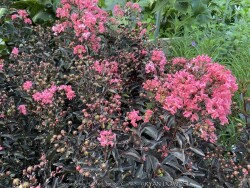
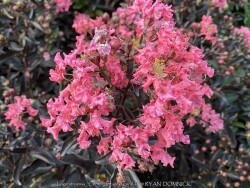
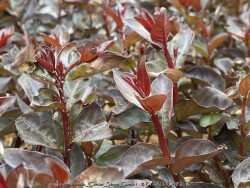
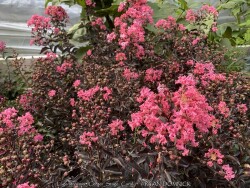
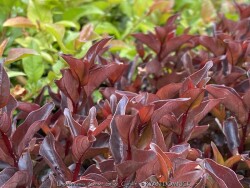

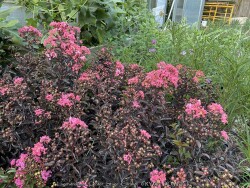
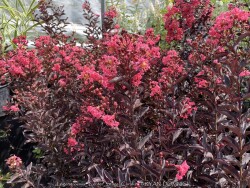
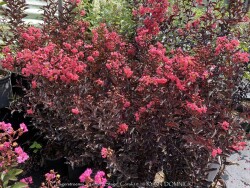
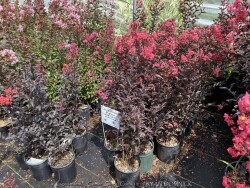
Plant Min Zone: 5b
Plant Max Zone: 9b
Sunlight: All Day Full Sun, Full Sun
Water / Rainfall: Low, Average, High
Soil Quality: Average, Rich
Bloom Season: Summer, Late Summer, Fall
Flower Color: Magenta
Berry / Fruit Color: None
Spring Foliage Color: Purplish Black
Summer Foliage Color: Purplish Black
Fall Foliage Color: Purplish Black
Evergreen Foliage: No
Winter Interest: No
Scented Flowers: No
Drought Tolerance: Medium, High
Wet-Feet Tolerance: Low
Humidity Tolerance: High
Wind Tolerance: Medium, High
Poor Soil Tolerance: Clay Soils
Height: 3' - 5'
Width: 2' - 3'
Growth Rate: Medium, Fast
Service Life: Long: 5-10 years
Maintenance Need: Low
Spreading Potential: Low
Yearly Trimming Tips: Shrub Normally Winter-kills so trim to 3-6" off Ground in Winter or Early Spring: Blooms on New Wood.
Plant Grouping Size: Specimen Planting of 1-3, Small Grouping of 3-5, Medium Grouping of 5-10
Best Side of House: South Exposure, West Exposure
Extreme Planting Locations: Survives Severe Drought, Tolerates Extreme Heat
Ornamental Features: Multiple Seasons of Interest, Long Blooming Season, Exceptional / Colorful Foliage
Special Landscape Uses: None
Possible Pest Problems: Beetles
Plant Limitations: May get Occasional Winter-kill, Needs Thick Winter Mulch, Late to Emerge or Leaf Out in Spring
Shippable in 2026: YES
Crapemyrtle (Lagerstroemia) is a beautiful summer flowering shrub that dies down to the ground as a perennial each year in Zone 6 Kansas. Flower colors include bright red, pink, magenta, purple, and white. Many cultivars have been released improving foliage color, disease resistance, and flower blooming length. Newer cultivars now have maroon or reddish foliage adding interest before blooming. Beautiful fall color is often overlooked; shades of red, orange, and purple develop when Night temperatures reach into the 40s. In Kansas, crape myrtles grow best with hot south or west exposures or on south facing berms or hillsides. But they are suitable in any garden location as long as they are in full sun, they will build enough energy to come back from complete winter top-kill each year. Generally are 40 inches of rain per year is sufficient without extra watering, but if drought conditions occur, flowering will be reduced or shortened. Brief periods of excessive water and saturated soils are tolerated adding to their versatility. Many people from the south associate Crapemyrtles as a tree. That is true that in Texas and much of the Southeast, beautiful tree forms with exfoliating bark will occur because of mild winters. In Oklahoma and Arkansas for example crapemyrtles are usually grown as large shrubs experiencing major winterkill every 5-10 years. In Kansas and Missouri, or where temperatures regularly get to 0°, all top growth will die back and they will be grown as a woody perennial. After flowering and beautiful fall color is dropped, many people leave crapemyrtles throughout the winter to enjoy the winter interest of the dried seed heads. By March or April, cut plants close to the ground and watch for new growth. Flowering occurs on new wood and is much larger and more dramatic on sprouts from the ground. Flowers are often twice as big when grown this way. In the past, only fast-growing tree size cultivars for appropriate and Kansas because they have the ability to recover the fastest from complete winterkill and grow into a flowering-sized shrub by July. Now there are dwarf cultivars that are wood-hardy to -10 zone 6 for those not wanting to worry about winterkill. No disease or pest problems. Crapemyrtle are awesome for pollinators in the late season garden and especially effective when combined with vitex, butterfly bush, and/or caryopteris. Lagerstroemia 'Center Stage Coral' is a new Proven Winners® release. This 3-5' shrub features deep black foliage and pink flowers with yellow stamens; it truly will command center stage in your landscape. Note that this cultivar is wood hardy down to zone 6b. All Proven Winners® plants are legally propagated, healthy and vigorous, true to name, and tagged with color pictures and growing information.